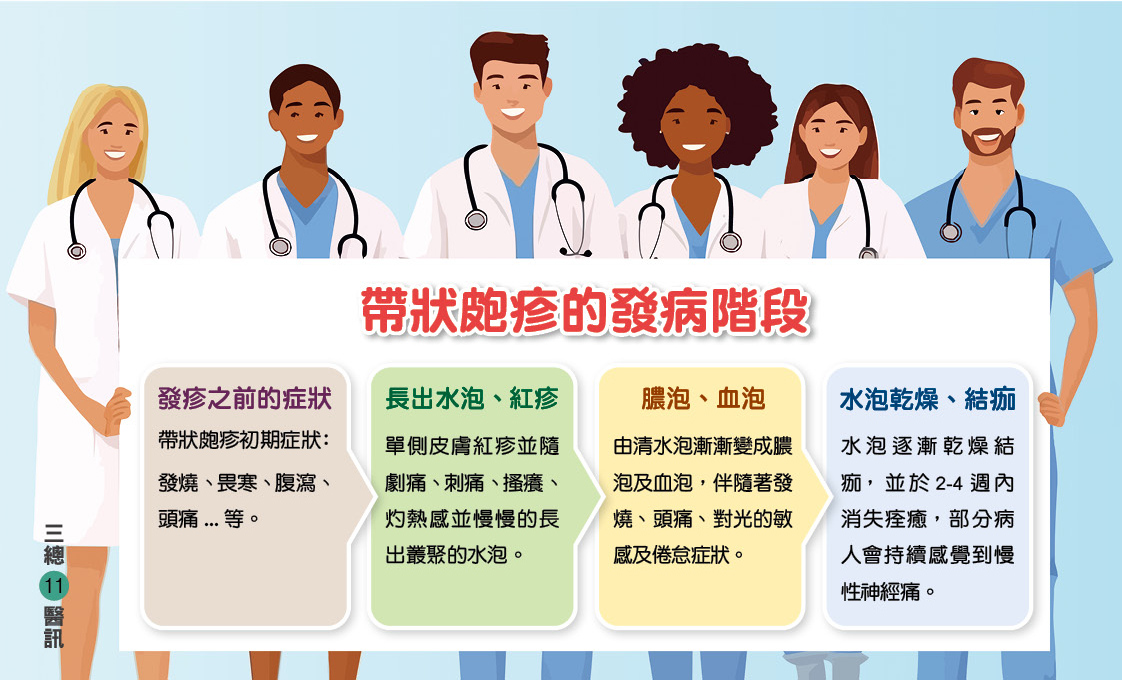Understanding and Prevention of Herpes Zoster
Update Date:2025/03/05,
Views:101
Dr. Hung Chih-Tsung, Department of Dermatology
What is Herpes Zoster?
Herpes zoster, also known as shingles, is a disease caused by the varicella-zoster virus (VZV). When a person is first infected with this virus, they develop chickenpox. After recovery, the virus remains dormant in the nerve ganglia. If the immune system weakens, the virus can reactivate, spreading along nerve fibers and causing herpes zoster. Studies indicate that over 90% of adults over the age of 50 carry this virus, and 1 in 3 people may develop herpes zoster in their lifetime.
Clinical Symptoms and Disease Progression
The clinical symptoms of herpes zoster can be divided into three stages: the prodromal phase, the acute phase, and the postherpetic phase.
Prodromal Phase (Approximately 4 Days to 2 Weeks): Before the appearance of the rash, patients may experience systemic symptoms such as fever, headache, and fatigue, as well as abnormal sensations in the affected area, including burning, tingling, or itching.
Acute Phase (Approximately 2 to 4 Weeks): A blistering rash appears in a dermatomal distribution on one side of the body, accompanied by pain. These blisters eventually crust over and heal, though scarring may occur.
Postherpetic Phase: Notably, about 30% of patients may develop postherpetic neuralgia (PHN), a persistent pain that can last for months or even years, significantly compromising quality of life.
Treatment
Early diagnosis and treatment are key to alleviating symptoms and preventing complications. Physicians usually diagnose herpes zoster based on the characteristic rash and symptoms, and may prescribe antiviral medications such as acyclovir or valacyclovir. These medications should ideally be started within 72 hours of the appearance of the rash for optimal effectiveness. In addition to antiviral medications, physicians may prescribe pain relievers as needed to manage pain.
Daily Life Considerations
1.Keep the affected area clean and dry, avoiding scratching or damaging the skin.
2.Avoid contact with individuals who have not had chickenpox or have not been vaccinated against it, particularly pregnant women, newborns, and individuals with weakened immune systems, until the blisters have dried.
3.Get plenty of rest, avoid overexertion, and maintain a strong immune system.
4.Wear loose, comfortable clothing to avoid friction and irritation on the affected area.
Prevention
The most effective prevention method is vaccination against herpes zoster. The newer recombinant vaccine, Shingrix, offers better protection, with an efficacy of 97% in adults over 50 and 91% in individuals over 70. The protection lasts for over 10 years. The vaccine requires two doses, with the second dose given 2 to 6 months after the first. Post-vaccination side effects may include local reactions such as pain or redness at the injection site, as well as systemic reactions like fatigue or headache. These symptoms typically resolve on their own within 2 to 3 days.
Special Reminder
Certain groups have a higher risk of developing herpes zoster, including:
•Adults over the age of 50
•Individuals with weakened immune systems
•Those using immunosuppressive medications long-term, such as steroids, biologics, or oral small-molecule JAK inhibitors
•Individuals with autoimmune diseases
•People who have previously had herpes zoster
If you experience symptoms suggestive of herpes zoster, seek medical attention as soon as possible to reduce the risk of complications. Additionally, preventive measures such as vaccination can significantly lower the risk of developing herpes zoster.
